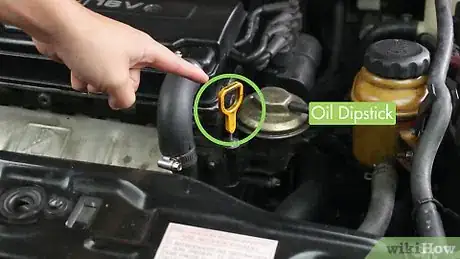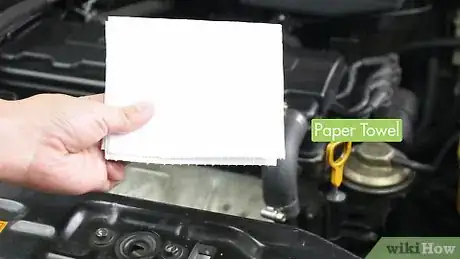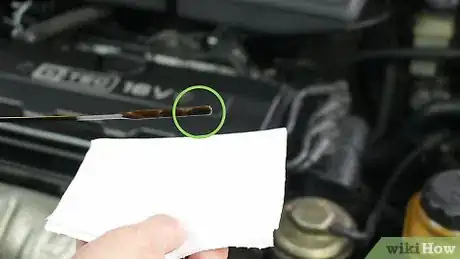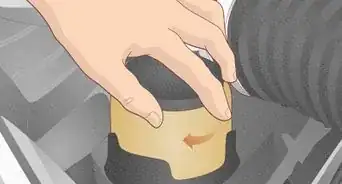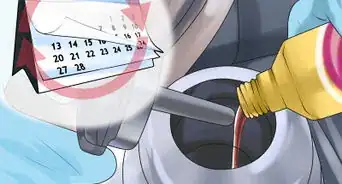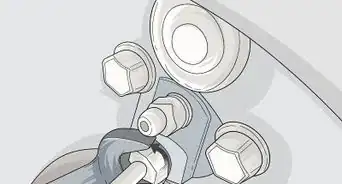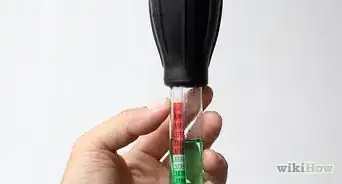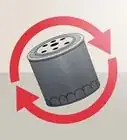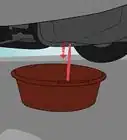This article was co-authored by Tom Eisenberg. Tom Eisenberg is the Owner and General Manager of West Coast Tires & Service in Los Angeles, California, a family-owned AAA-approved and certified auto shop. Tom has over 10 years of experience in the auto industry. Modern Tire Dealer Magazine voted his shop one of the Best 10 Operations in the Country.
wikiHow marks an article as reader-approved once it receives enough positive feedback. In this case, 100% of readers who voted found the article helpful, earning it our reader-approved status.
This article has been viewed 306,699 times.
Checking the oil levels in your car is essential to maintaining the life of the vehicle. It's one of the most straightforward bits of regular maintenance you can perform in your vehicle, important especially before long trips that will involve heavy engine use. You can learn to locate the right gauges in your engine compartment, diagnose problems with the oil in your car, and address those concerns if necessary.
Steps
Finding the Dipstick
-
1Refer to your owner's manual. Mobil One and other oil manufacturers recommend checking engine oil levels before driving your vehicle, when the oil is still cold. However, some manufacturers will recommend checking the oil after you've warmed up the engine, so check your owner's manual to find the specific recommendations for your vehicle.[1] You want the oil to be in the oil pan, not in the engine as it will be while you're driving. Immediately after driving, the oil level will appear lower, making it easier to overfill the oil. If you want to check the oil and have been driving the vehicle, wait five or ten minutes to let it settle into the oil pan before checking it.
- In very cold weather, it may be appropriate to drive the car around a bit first to get the oil loosened up and less viscous before checking it. Let the engine run for a few minutes, then let it cool down for five before you check it.
- Many people disagree about whether or not the oil should be checked hot or cold. Some manufacturers recommend checking engine oil warm, and it's perfectly fine to do so as long as you're looking at the right line. There will appear to be "less" oil on the gauge when the oil is colder, but the oil will thin out as the vehicle runs up to normal operating temperature.
- Synthetic oil expands more when it is hot than "regular" oil does, so it may be best to check your oil cold if you use synthetic oil. Talk to your mechanic if you aren't sure.
-
2Park the car on a flat even surface. To get an accurate reading, you'll also need to make sure the oil isn't sloshed to one side of the pan, which can give you a slightly inaccurate reading. Try to find a relatively flat surface on which to park and check your oil.Advertisement
-
3Pop the hood. Usually, there will be a latch somewhere at the foot of the driver side door that looks like the front of your car opening up. You'll pull or push this latch, depending on the make and model of the vehicle. Then, you'll need to exit the car and look under the front of the hood for a latch, usually at the center but sometimes slightly off-center. Pull this and raise the hood to examine the engine.[2]
- On some cars, the hood will stay up, while on others it will require a prop rod, which is usually folded up on the front or side of the engine compartment. Lift this support into place (there will be an opening on the hood to insert it) and let go of the hood.
-
4Locate the dipstick. On most cars, the oil dipstick will have a red, orange, or yellow cap. It's a circular or rectangular shape, and should be pointing out directly from the engine block, to one side or the other. Some vehicles, such as Hondas and some Fords, may have the dipstick point out directly from the top of the valve cover. Oil dipsticks are typically located towards the passenger side or near the front and are usually inserted into a dipstick guide about the size of a pencil.
- On most cars, there should also be a symbol that looks like an old-style oil can to demarcate the proper dipstick. When you've located the dipstick, you're ready to remove it and check the oil.
- Most automatic transmission vehicles will have two dipsticks under the hood, one for the oil and one for the transmission fluid. Transmission dipsticks are typically found at the rear of the engine bay or towards the driver's side, and the dipstick will commonly be inserted into a slightly larger tube. This transmission fluid is typically pink or red. Never confuse the two. Never put oil into the transmission, which can cost you serious money.
-
5Get some paper towels or an old rag. When you check your oil, it's important that you have a couple of paper towels or some other cloth that you can use to wipe it off and check the consistency of the oil. Paper towels usually work best, because it gives you a nice white backdrop contrast to examine the color. Also a great way to keep your hands clean.
Checking the Oil
-
1Remove the dipstick. Most dipsticks range from a foot to three feet, and you'll need to check the very tip to get the reading you're looking for. Slowly pull the dipstick out, holding a paper towel around the port as you pull, to wipe the oil off and keep it from flipping up and out.
- You shouldn't have to pull very hard or twist on most oil dipsticks, but you might have to use a little bit of strength to get it to come free. Once you've got the cap off, it should pull free quite easily. Don't force it.
-
2Examine the color and quality of the oil. The color and the consistency of engine oil is indicative of its age, and possibly of other engine efficiency issues that you might need to address. As soon as you remove the dipstick, you can get a good sense of the quality of the oil in your engine. Engine oil that's in good condition should look slightly yellow-greenish on the rag, and shouldn't be super-dark. Wipe the oil off the end of the dipstick and examine it on the rag.
- Oil will change in color from golden or amber colored to brown and black as more and more particulate gets in the oil from the engine. Metal filings and particulate will slowly scrape the cylinders of your engine over time, which is why the oil needs to be changed according to the manufacturer's recommended service interval (check your owner's manual or service booklet to find your vehicle's service interval).
- Look at the color, specifically. Does it look brackish, or chunky? Does it look black or dark? If so, it's likely a sign that your oil needs changed. Take the car in to have it serviced, or change the oil yourself.
-
3Dry off the dipstick and dip it once more into the hole. The first time you pull the dipstick out, you can't learn much about the amount of oil, since the dipstick will have oil stuck on it at many different points. Once you pull out the dipstick and examine the color, wipe off the end and reinsert it into the hole, then pull it back out immediately to get a good reading on the amount.[3]
-
4Check the amount of oil. There should be two small dots on the end of most dipsticks, and one corresponds to the maximum fill line in the oil pan and the other refers to the minimum. The minimum dot should be close to the tip, and the maximum should be about an inch or so up from that on the dipstick. In a properly filled car that's cool, the line should be just about halfway between the two points.
- In general, the "minimum" marker should be close to the very dip of the dipstick. If the line of oil on the dipstick is between the tip and that mark, you need to add oil to the car.
- The oil should never be higher than the maximum fill point, though it will be close to that point when the oil is hot. If it is, you may need to drain some oil from your car.
Adding Oil
-
1Check your user manual. Before you try to add oil, you need to find out what kind of oil your car requires. It's important to always check, because the types vary, even from one model and season to another. It's generally unwise to mix different grades of oil, so check carefully with the manual or your local mechanic before you add oil to the car.
- Alternatively, you can also talk with the staff at most auto supply stores to figure out what kind of oil you need to put in your car. As long as you know the make and the model, they should be able to look it up and tell you, or you can look it up yourself in the manual in the oil section.
-
2Locate the oil fill cap located on top of your engine. These caps are typically well marked with the words "Oil Fill" and sometimes with the grade of engine oil your vehicle uses. If you see 5w30, for example, written on the cap, you'll know what kind of oil you need to add. Remove the cap, wipe it off with a paper towel or the rag you've been using, and insert a clean funnel.
- You need to use a funnel to add engine oil, or you'll risk spilling it all over the engine block, which will burn off and create a terrible smell, and possibly worse problems.
-
3Add the appropriate oil in small increments. It's important to allow time for the additional oil to drain down into the oil pan. It should fill it up the funnel suddenly and then glug down slowly. Avoid overfilling the funnel.
- If you spill a little bit of oil on the engine compartment, don't panic. Spilled oil tends not to be super-dangerous, though it will smell bad and may smoke some. Try to wipe it up as best you can with a rag or a towel.
-
4Check the oil again. Remove the dipstick and check the level. Repeat this process until the appropriate amount of oil is showing on the dipstick. Wipe the stick off after each read. Once you have finished, double check that the dipstick is fully seated and the oil fill cap has been tightened. Double check any other locations you have checked, remove any rags, paper towels or oil bottles. Lower the hood prop and close the hood.
Expert Q&A
Did you know you can get expert answers for this article?
Unlock expert answers by supporting wikiHow
-
QuestionWhen should I add oil to my car?
 Tom EisenbergTom Eisenberg is the Owner and General Manager of West Coast Tires & Service in Los Angeles, California, a family-owned AAA-approved and certified auto shop. Tom has over 10 years of experience in the auto industry. Modern Tire Dealer Magazine voted his shop one of the Best 10 Operations in the Country.
Tom EisenbergTom Eisenberg is the Owner and General Manager of West Coast Tires & Service in Los Angeles, California, a family-owned AAA-approved and certified auto shop. Tom has over 10 years of experience in the auto industry. Modern Tire Dealer Magazine voted his shop one of the Best 10 Operations in the Country.
Auto Technician
Warnings
- If the oil level is under minimum, you can risk serious damage to your engine.⧼thumbs_response⧽
- Don't over-fill your oil either. If you add too much oil, it will foam up when it hits the crankshaft, and it will cause engine performance issues.⧼thumbs_response⧽
References
About This Article
To check the oil level in your car, first make sure you're parked on a flat area and the engine is off and cool. Then, pop the hood and locate the dipstick, which is a long rod with a ring on the end of it that's usually found near the front of the engine block. The oil dipstick is almost always yellow and it often says “Engine Oil” on top. Slide your finger inside the ring on the end of the dipstick and slowly pull it out. Use a rag or paper towel to wipe off all of the oil on the end of the dipstick. Then, slide the rod back into the opening you pulled it from. Push the rod all the way down and slowly remove it again. Now, inspect the dots at the end of the rod to see how high the oil reached. If the oil is above the bottom dot, your car's oil level is fine. If the oil is at or below the bottom dot, your car will need an additional 1 quart (950 mL) of motor oil. To learn more from our Mechanic co-author, like how to add more oil to your car if you need it, keep reading!
